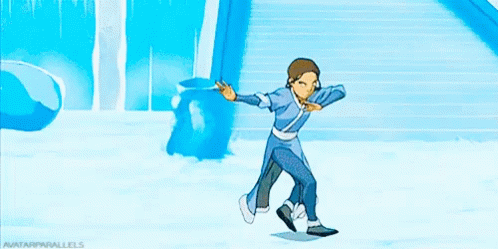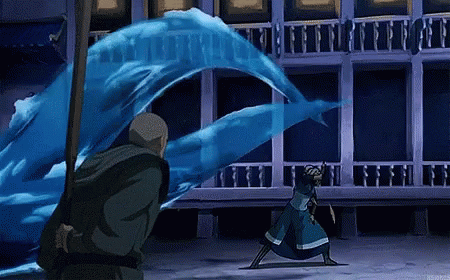Hello and welcome to part 3 of our Avatar: The Last Airbender series. Today, continue with the Avatar cycle and flow into Water Bending. In Avatar, Water Bending is characterized by flexibility, adaptability, and healing. Water Benders understand the movement and flow of water, the rhythm of the seas. They understand that water changes, yet never loses its essence. Through Water Bending, we learn to navigate our experiences with grace and flexibility.
Become the Water
To emulate the Water Benders, we begin with acknowledging our thoughts and feelings. We want to view these as a pool of water, and we are just floating with them. We don’t need to dominate, control, or resist; we simply float and flow in the same way water moves around obstacles. And we learn to flow with the water, like a leaf in a stream. The stream may become tumultuous, or it may be calm. It may wind and turn or it may flow along a more straight path. Either way, we are flowing with it.

The following exercises are to help us tap into that flow and focus on moving with the currents of life as they come. Throughout it all, remember to pay attention to thoughts and feelings. However, this time, we are going to flow with these thoughts and feelings rather than simply observe them. Notice the changing nature of our thoughts and feelings throughout these exercises.
As always, take time after each exercise to reflect.
Shaping the Stream
Crafting Water’s Way – This exercise requires the use of art materials such as paper, watercolor paints, and sharpie pens (no need to go overboard on art supplies, the inexpensive stuff is just fine). Start by connecting with your thoughts and feelings. Then, on your paper, use your sharpie pen to start making lines that don’t follow repeated patterns or designs. Start and end the line on the edge of the paper. You can take as long as you want with this, making as many overlaps as you like. Wherever a line does overlap, use your pen to turn the cross-sections into smooth U shapes. Use both thick and thin sharpie pens to smooth out or thicken lines. Go with what feels natural and follow the flow. Give the sharpie some time to dry (usually only needs a minute or two) and then go back and paint over your image with watercolors.
Water’s Flow – For this exercise we are going to combine movement and breath to create a sense of flow using Yoga! This exercise requires some basic knowledge of different yoga poses. If you are unfamiliar with Yoga, I highly recommend that you check out Yoga With Adriene on YouTube. She has some phenomenal beginner videos to get you going with your practice. As mentioned, throughout this exercise, we want to connect each inhale and exhale with a movement. Here is an example flow, but if you have a flow practice already, you can use that!
Begin in Mountain Pose and inhale into Upward Salute (Mountain pose but with your arms up).
Exhale into a Forward Fold, inhale into a Half Fold, exhale into Forward Fold
Inhale as you release the hands and bend your knees and step back with your right foot into a Low Lunge
Exhale as you raise your Torso, inhale lift your arms, exhale lower your arms (all while in Low Lunge)
Inhale and move into a Plank position, exhale into Chaturanga (plank, but with arms bent at a 90-degree angle), inhale into Up Dog/Cobra (What’s Up dog? Nothing, what’s up with you?), exhale into Down Dog, take an inhale here as well.
Exhale and move into Forward Fold, inhale to Half Fold, Exhale to Forward Fold
Inhale as you move into Upward Salute, and exhale into Mountain
Repeat, but this time step back with your left leg into Low Lunge.
Mind Current – The following exercise utilizes handwriting though please feel free to adapt it to your needs. We start by using our writing utensil to begin writing down thoughts and feelings as they come into our head. Do not worry about grammar, legibility, penmanship, sentence structure, or tone. Just go with it and let the thoughts and feelings flow through you and onto the paper. If you are struggling with thinking of anything, it is perfectly appropriate to write down “I can’t think of anything” or repeating “blah, blah, blah” over and over for the entire exercise. If you get distracted, write that down too “I was distracted” Just do your best to maintain the flow of writing throughout the entire exercise. Practice letting go of self-judgment and expectation throughout the entirety of the exercise. I recommend giving yourself a time-limit or a page limit, but you can simply write until you feel done. You may also do this exercise using technology such as your phone's note-taking app or word on a computer. You can also simply dictate to a recording device if that works for you as well.

Embracing the Moon
In Avatar, the moon was the original teacher of the Water Benders. And much like Water Benders, we too can turn to the moon to help us in going with the tides of life and flowing through each day. Remember to embrace fluidity in your experiences – the highs and lows, the ebbs and flows. When overwhelmed, imagine yourself floating in a cool calm pool. If you are feeling stuck, try expanding awareness like the vastness of the ocean. Through these practices, and an embrace of Water Bending philosophy, we can learn to move with the flow of life rather than against it. We learn to let our thoughts come and go, like the waves on the shore. Just remember that you are not simply the waves; you are the ocean.
Continue flowing, continue growing, and until next time, keep it fluid!

As a final note, this blog included many movement and Yoga-based exercises. If this is something that resonated with you, and you would like to explore these concepts further, I highly recommend reaching out to Applehelen Kirby, LMHC at A New Hope Therapy Center.
Zachary Dehler Egan (Zac, He/Him) is a Licensed Clinical Social Worker with a focus for helping people foster emotional and social growth and healing. He is passionate about utilizing geek/pop culture based therapy for individuals 14 and older. This includes tapping into people's fandoms, utilizing board and tabletop games, and even video games to help people achieve their mental health and social skills goals. Zac has received training in using Solutions Focused Brief Therapy, Dialectical Behavior Therapy, Cognitive Behavioral Therapy, EMDR, and Mindfulness therapy which he incorporates into his sessions and interventions. He also loves playing Tabletop Role Playing Games, Tabletop Wargames; reading Fantasy and Science Fiction books; watching movies and video gaming. Some of his fandoms include Star Wars, the Marvel Cinematic Universe, DC Comics, Disney/Pixar and animation in general, and The Wheel of Time series.
